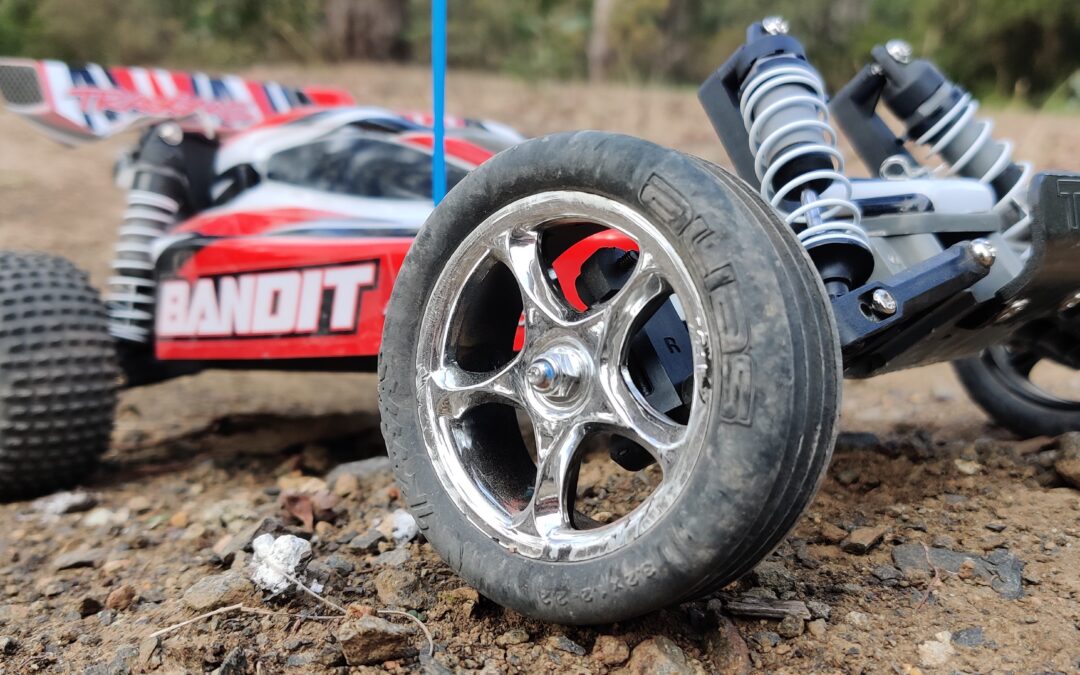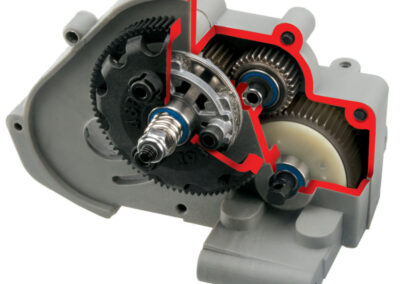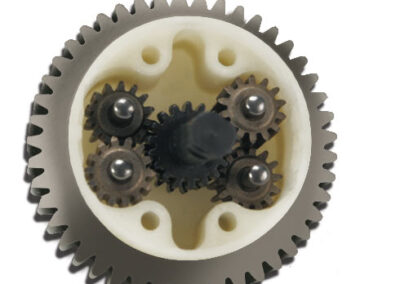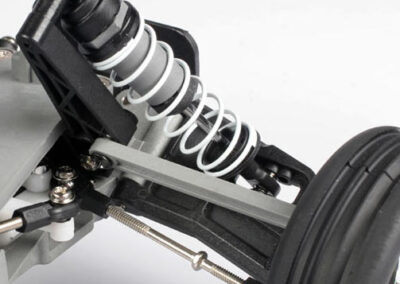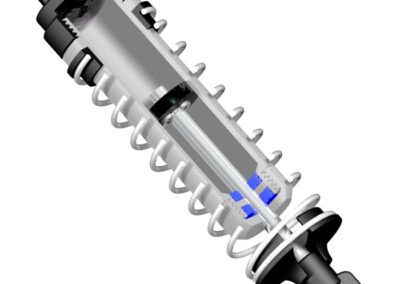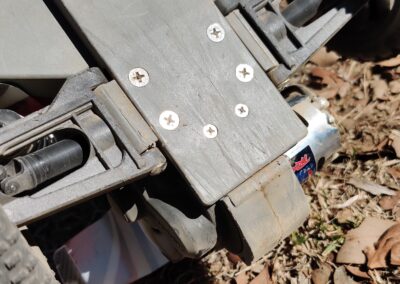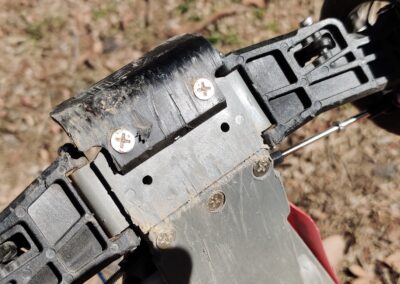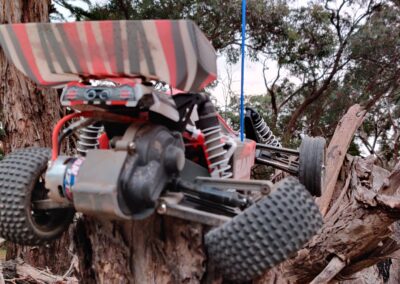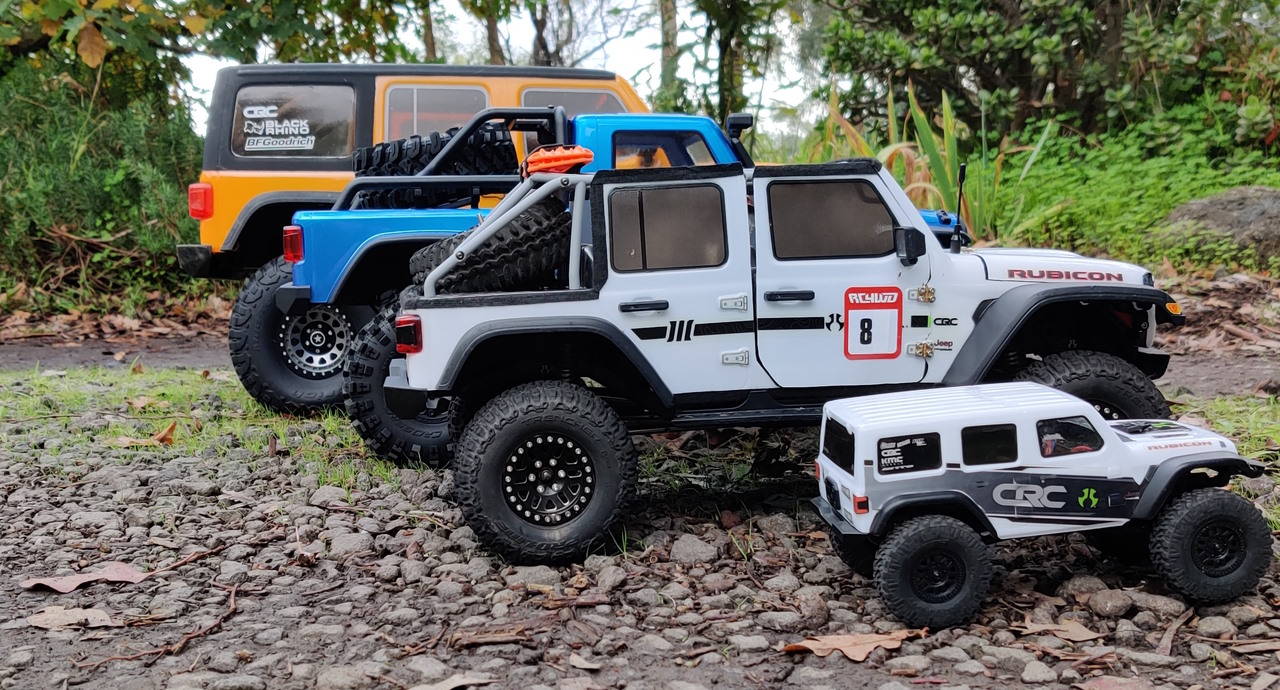We take a close look at the Traxxas Bandit XL-5 1/10 Scale, 2WD, Ready-To-Race RC Buggy (Traxxas models 24054-4 & 24054-1).
Where It All Began
The Traxxas Bandit has been a household name for RC bashers and entry level racers for decades. Punting an RC car off the curve and up the street is almost a rite of passage for the RC enthusiast of the Western world. For years, RC drivers have been enjoying their short course trucks, stadium trucks, monster trucks, road cars and of course, buggies! On the street is where it often starts, and on the track is where things get interesting.
In 1995, Traxxas released a model that would be on store shelves for decades under the same name and with a similar overall build. That model was the Traxxas Bandit 2WD Buggy.
Changing With the Times
The original Traxxas Bandit had a Stinger 540 motor with 26mph (or 42km/h) top speed on a 7-cell battery. It used the same Magnum 272 transmission found in other Traxxas machines, such as the Slash and the Rustler. There were common parts over these models too, though the Bandit was always the narrow option and very light in the nose.
Over the years, the Magnum 272 planetary transmission has remained. The transmission has been updated to a tougher variant that uses real ball bearings and stronger gears. The Titan 12-turn motor is now a bigger 550 unit than the 540 Stinger – and there’s even a brushless Bandit variant. Plastics and links have changed over the years as well, and there are still shared components across the Slash, Rustler and Stampede 2WD platforms. Even with the updates, the Traxxas Bandit is still a solid and reliable buggy that’s at home bashing in the backyard and still a cheap starter platform for grassroots dirt track racing.
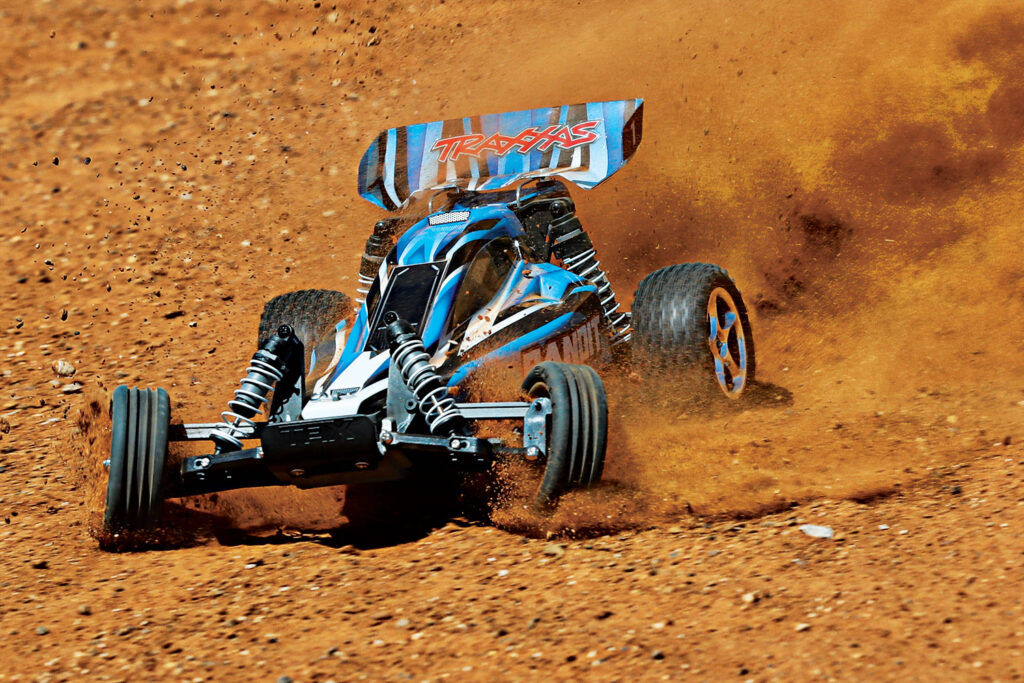
The Modern Traxxas Bandit
Traxxas claims a top speed of 35mph (or 56km/h) for the current brushed model. This is with an optional 31-tooth pinion and 8.4v NiMH battery. You can mod nearly any rig to be a straight-line champ, but the Bandit is not a speed-running beast. Its big suspension hints at its dirt track roots,
With the included 21-tooth pinion, you can expect a maximum speed of 23mph (or 38km/h). This may sound slow, but in the context of a RWD buggy to be used on gravel and dirt short courses with many turns and a few jumps, acceleration may actually be the greater concern. Again, this is not a racing buggy so much as a fun machine, so the maximum speed feels about right. Courses with long straights will certainly make the Bandit seem slow, but on tighter courses it may actually be rare to have the throttle completely open.
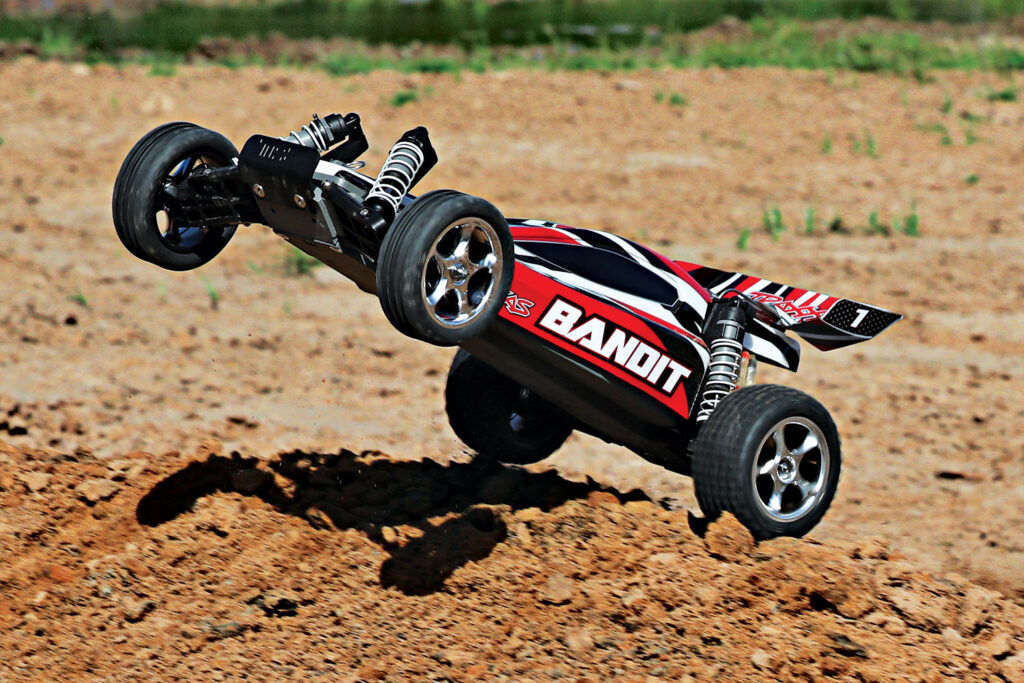
Bandit XL-5 Variants
Firstly, there are two variants available of the Traxxas Bandit XL-5:
- Model 24054-4: Fully assembled, waterproof, Ready-To-Race®, with TQ™ 2.4GHz radio system, XL-5 Electronic Speed Control, and ProGraphix® painted body; and,
- MODEL 24054-1: Fully assembled, waterproof, Ready-To-Race®, with TQ™ 2.4GHz radio system, XL-5® Electronic Speed Control, 4V NiMH 3000 mAh Power Cell™ battery, 4-amp DC Peak Detecting Fast Charger, and ProGraphix® painted body.
Our unit was the 24054-1, which includes the 4-amp DC charger and a 7-cell 8.4v 3000mAh NiMH battery. For both models, you need to supply your own AA batteries for the transmitter (x4), but everything else needed to run is included on the -1 variant.
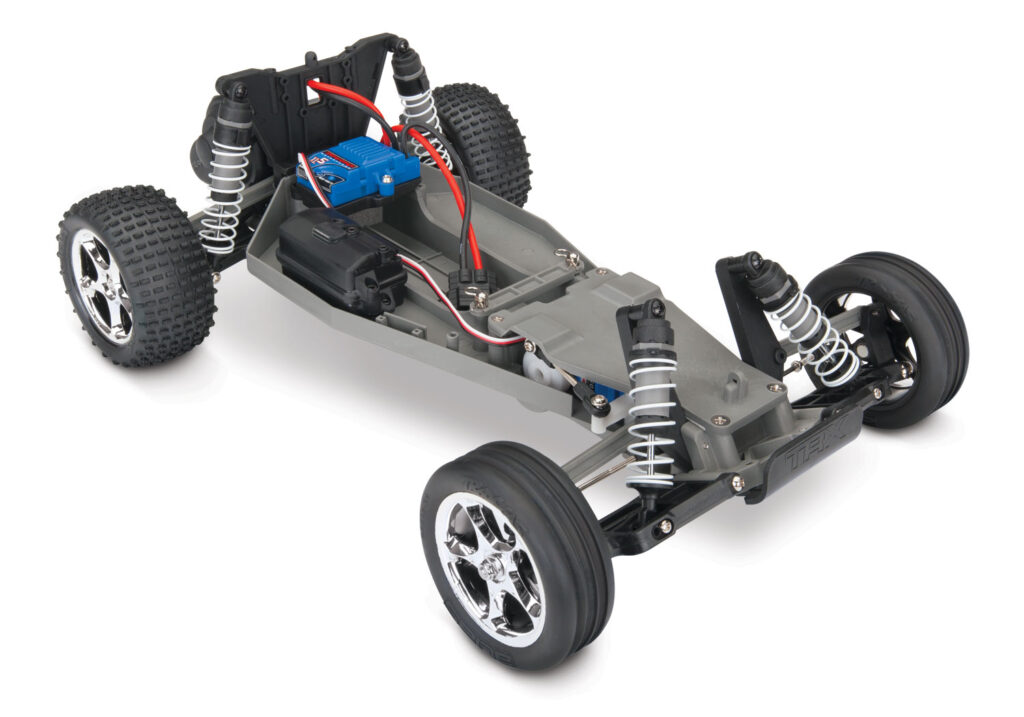
Vehicle Specs
The Traxxas Bandit XL-5 is 16.25” (or 413mm) long and 9.84” (or 250mm) wide. The vehicle chassis itself is quite narrow, so the width here is also its track width, front and rear. It’s a low vehicle, at 7” (or 178mm) tall, excluding antenna pole. Vehicle wheelbase is 11.25” (or 286mm) and it weighs 48oz (or 1.36kg), excluding battery. Find the full Bandit specs page here.
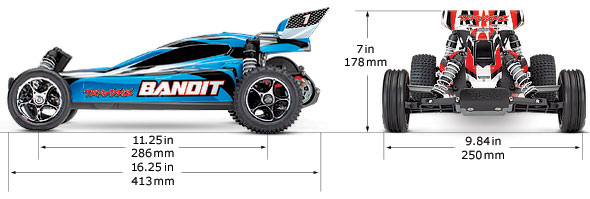
Traxxas XL-5 ESC
The Traxxas XL-5 Electronic Speed Control (ESC) powers the motor and the electronics. It handles 4-7 cell NiMH and 2-cell LiPO batteries. It has a built-in Battery Eliminator Circuit (BEC) that outputs 6v 1A. Read more about the ESC here.
The ESC features Low Voltage Cutoff (LVC) for LiPO batteries. It is easily toggled between NiMH and LiPO profiles with a 3-second hold of the button after turning it on. Red is NiMH, green for LiPO. Simple! The ESC also features a 50% power limiter for young and new drivers who need a lower top-speed whilst learning to drive smoothly.

Traxxas Titan 12T 550 Motor
A 550 motor has greater torque than an equivalent 540 unit, though it has marginally lower acceleration. It can handle greater current without the heat of a 540 of same spec and its well-suited to the Bandit. Full throttle with a full battery gives plenty of speed.
Both the motor and the ESC become hot with hard use, but not so much that they are damaged. The electronics should stand up to extended use in all conditions – though mud in the motor will lead to premature failure. A garden hose to wash out the motor after especially muddy runs is usually a good idea!
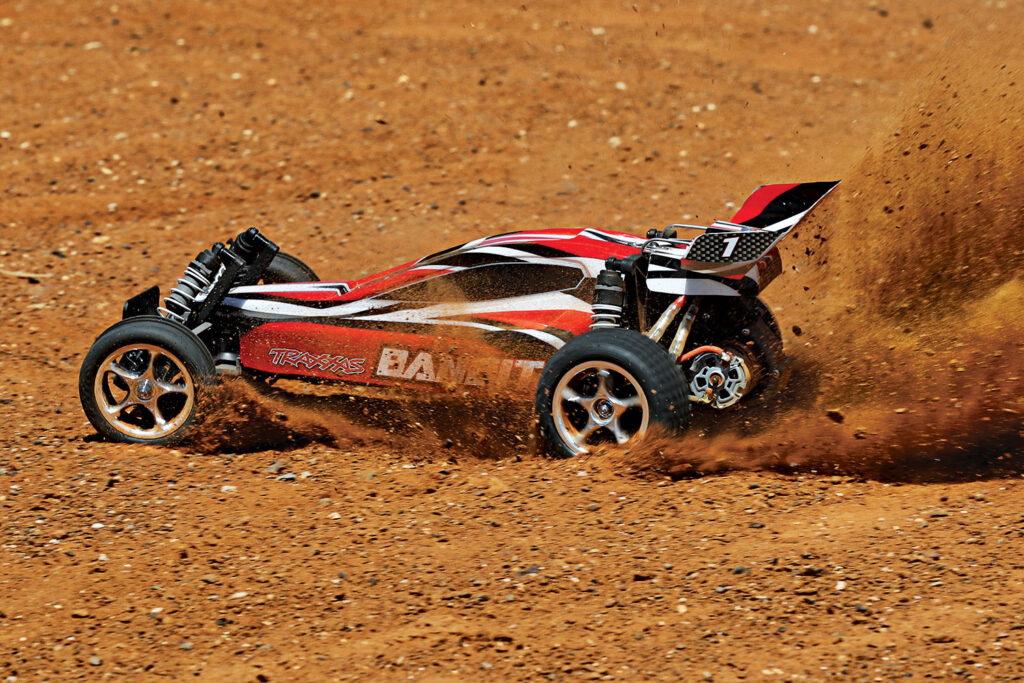
Traxxas TQ Radio System
The radio is the Traxxas TQ 2.4GHz 2-channel transmitter. The receiver is the Traxxas TQ 3-channel micro unit (#6519). Traxxas #2056 High Torque Waterproof servo handles the steering and the Traxxas Titan 12T 550 motor drives the buggy.
The radio receiver is safely enclosed within a waterproof receiver box and the entire model can be driven in the wet. The only thing to worry about is the radio transmitter getting wet if you’re in the rain. A plastic bag over the transmitter and wrapped around your hand is a quick and easy way to protect it. You can steer through the bag with your other hand and everything stays dry.
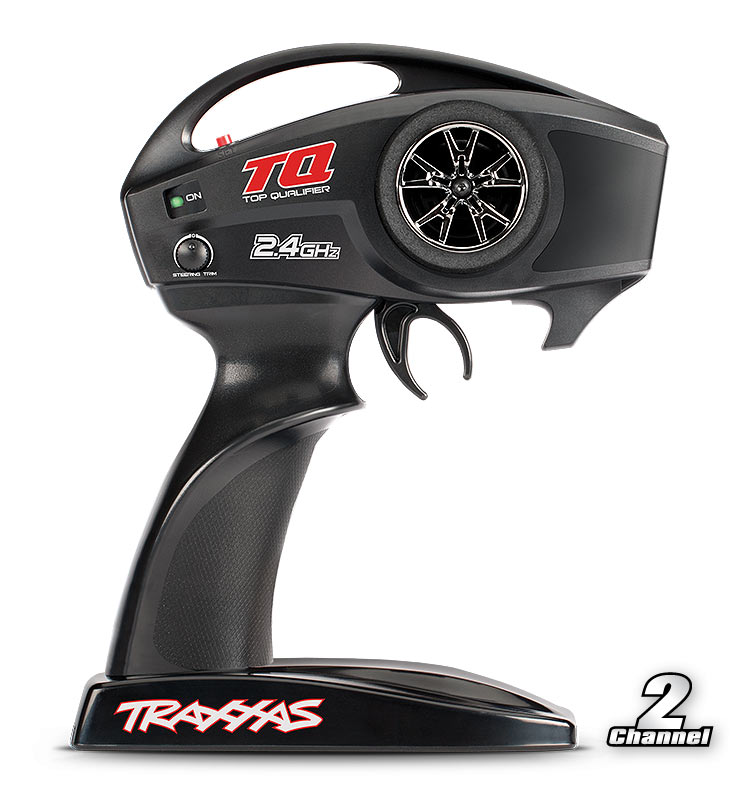
Traxxas #2056 Servo
Rounding out the electronics is the Traxxas #2056 High-Torque Waterproof steering servo. We’ve had probably a dozen of these servos in various models here over the last decade. They’re plastic geared but quite tough and reliably waterproof. The #2056 servo runs at 6v.
Though not hugely fast nor strong compared to the nicer options after-market, for a stock servo it’s a fine choice for the Bandit. It doesn’t have to be as strong as it is, with 80-oz of torque, but it could use a little more speed. The #2056 is a good choice for the Bandit and the servo is easily upgraded if you so desire.
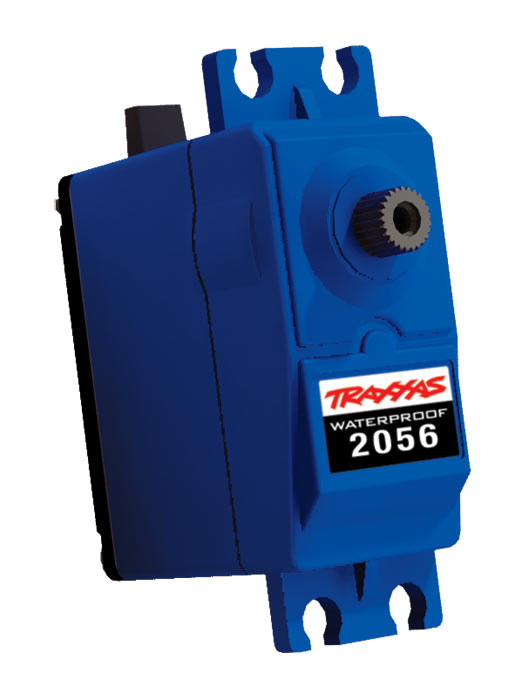
Steering
The Traxxas #2056 servo manipulates a bell-crank system for steering. Bump steer is minimised and angles are optimised for accurate control on both wheels. The steering parts are a mix of stainless-steel links and nylon arms – the bell-crank itself is nylon, with two bearings within the central shaft. The whole system is protected with an integrated shield in the chassis on the top side, and the tub chassis’ base and sides keeping stones and debris out underneath.
It works well enough and there’s room to fit upgraded servos if greater speed is needed. The torque at least is sufficient with the stock unit, particularly given the small size of the undriven front wheels on the Bandit. The system works well and there’s a good amount of flex to handle those nasty, heavy landings. Our unit took several wheel-first hits and seems none the worse for it, so it’s a Pass from us!
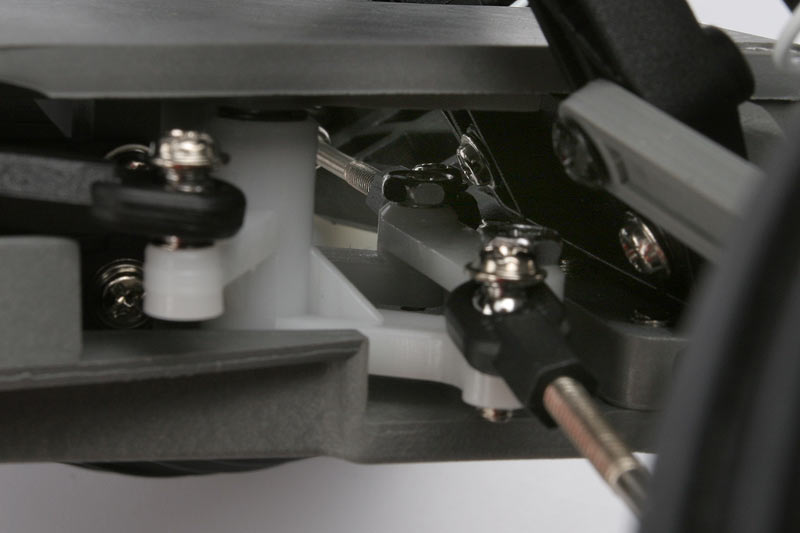
Bandit Wheels & Tires
The Bandit rides on mirror-chromed 2.2″ Tracer™ five-spoke wheels with pre-glued tires and foam inserts. The rear tires have step-pin tread and the fronts are ribbed. The wheels accept a wide array of accessory tires including the Traxxas Anaconda® 2.2″ street tires for Bandit and other buggies.
We found the rears hooked up nicely on gravel and dirt. The fronts provided ample steering as long as the buggy wasn’t under acceleration. Buggies tend to lift the nose, being so light up-front, so you need to come off the throttle to steer. The wheels’ chrome finish chipped quickly and looked ratty after just a few runs. The front tires came unglued from the wheels in an equally short time – were they glued in the first place? Maybe not – it isn’t hard to rectify this, in any case. A quick clean and then a few drops of super glue on the rim and the tires will stay put.
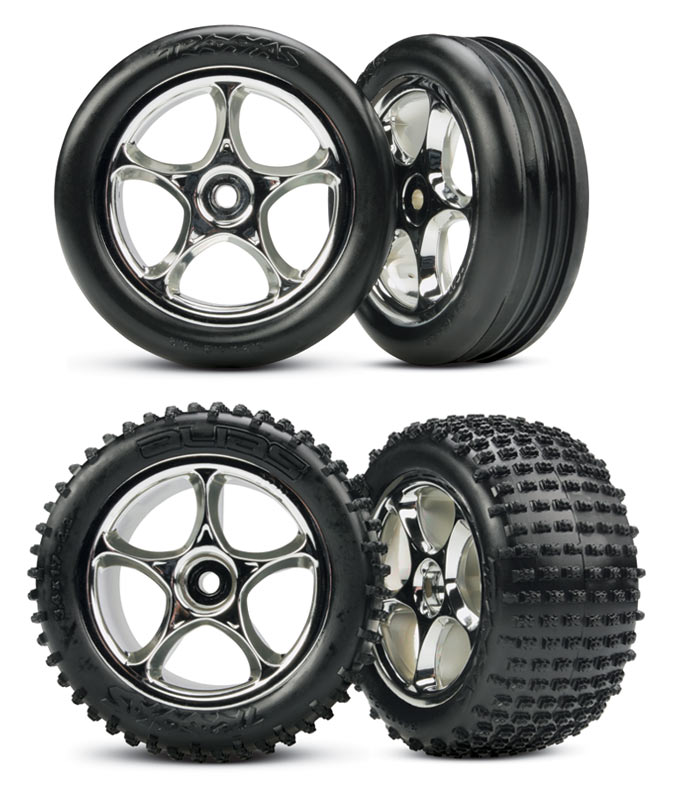
Body and Wing
Polycarbonate plastic comprises the Bandit body. The rear wing is also made of this light and flexible material. It looks great, but we’ve gotta wonder whether that wing will be destroyed prematurely with a few bad landings. Many other makes of vehicle use an ABS plastic or flexible Delrin for exposed pieces like a rear wing. The Bandit’s polycarbonate wing seems positively flimsy in comparison.
That said, over three batteries we landed on the wing maybe 7 or 8 times (I know, I know – practice needed!!). The wing has some dents and marks on it and the paint is chipping. However, it’s still largely intact. The wing is tougher than it looks and though it won’t last forever, it’s not the terrible design decision it may first seem to be!
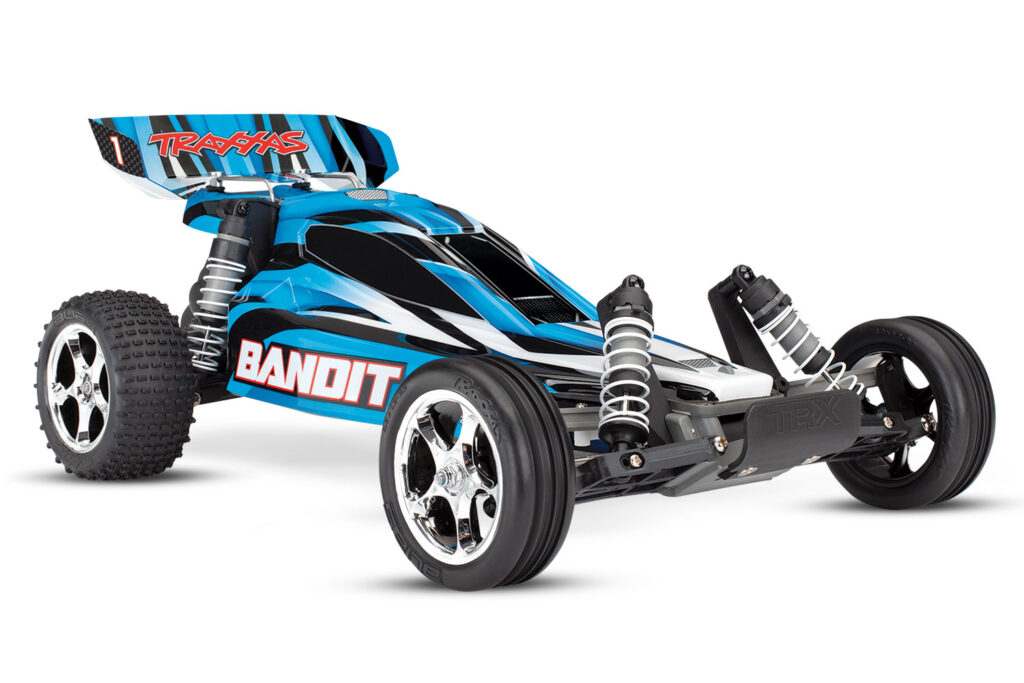
Diff and Transmission
The transmission goes by the same name of the original: Magnum 272. It employs 48-pitch gears and is ready for brushless without needing further upgrades. This is a nice touch! The spur gear is nylon, quite normal for this type of implementation. If you ever have to move the motor to clean or service things, or replace the pinion, be sure to set your gear mesh as finely as possible. 48-pitch gears have less tolerance for excess gaps, so stripping the spur gear is a likely outcome if not done correctly!
That said, as long as things are done right, the gears will serve you well for a long time. The gears other than the spur are of hardened steel and the transmission uses sealed ball bearings throughout. The transmission also features a slipper clutch that is adjustable in the usual way, with a locknut over a spring to set pad tension.
The diff is a planetary unit comprising multiple parts. There is a set of 4 hardened steel gears internally, plus a hardened steel outdrive on both sides from the centre. The diff casing is nylon and then the ring gear is also hardened steel. The diff is tough and though the steel gears will mean more noise than plastic gears would ever come close to making, the trade-off with longevity should be easily worth it. We’d expect this diff to outlast most motor configurations, brushless included. It’s a properly solid unit.
Motor Mount
The motor mount completes the transmission seal, keeping out dirt and debris whilst also keeping the motor cool. The cooling channels work in conjunction with the internal fan in the Titan 550 motor to help keep the temps down.
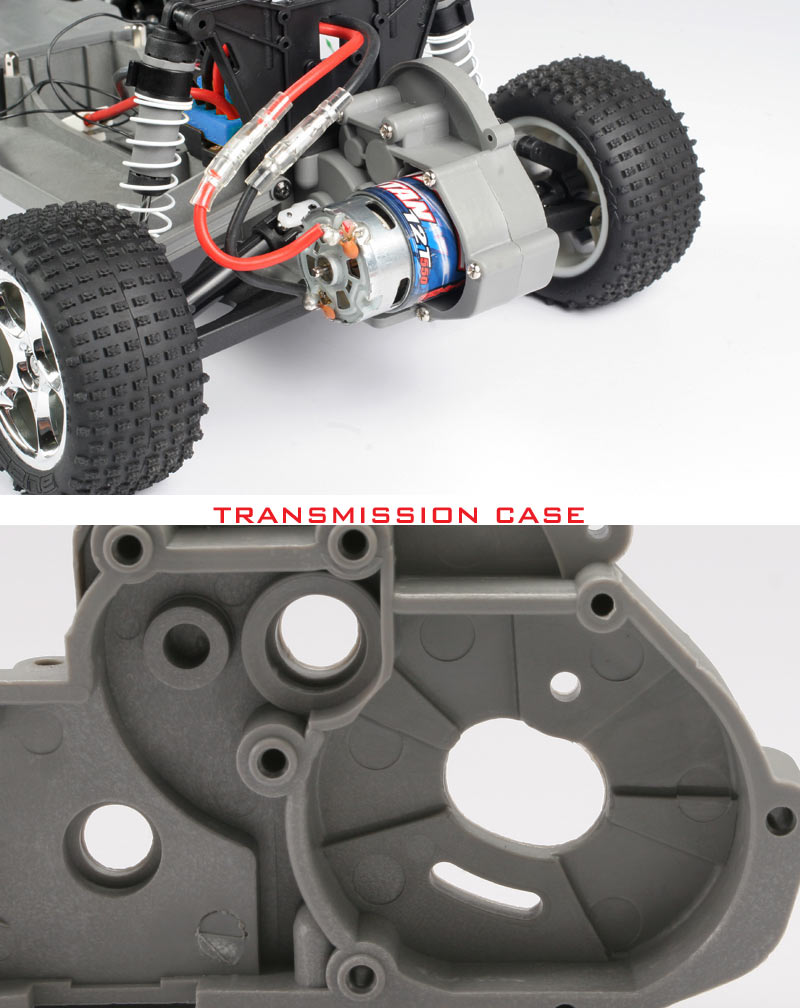
Drive Shafts
The Bandit employs plastic, telescoping driveshafts. They are the same type that are used on both the XL-5 (brushed) and VXL (brushless) vehicles across the Bandit, Rustler, Slash and Stampede range. Under bigger power systems, these tend to break after fatiguing from torque. However, with the lower power from the brushed systems, they should last the life of the vehicle in many cases.
You should be aware that if a rock gets caught between the arms and the shafts, the rock can grind away at the shaft plastic until it snaps clean through. Ours has already begun to do this after just three battery packs. There are metal shafts readily available from a variety of sources.
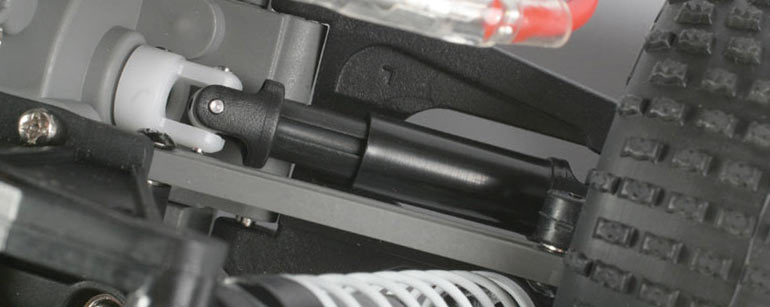
Battery and Chassis Layout
The battery bay on this chassis can fit anything up to about 6500mAh 2S LiPO, or a 7-cell NiMH pack – including most ‘hump’ packs. There’s plenty of vertical room for fatter, shorter packs as well. Battery retention relies on the battery being long enough to fit under the ESC at one end and under the battery clip at the other, so if you have a shorter pack you may need to get creative with securing it. In any case, the space is generous and the supplied battery with our unit was snug and secure.
The ESC is lightweight, so it isn’t a big deal for center of gravity to have it sitting above the battery. The motor sits low in the rear at just above axle height and the steering servo is low and forward near the front axle line. The underside of the chassis is mostly flat and the buggy is overall quite streamlined. It’s an attractive machine in either the red or blue finish.
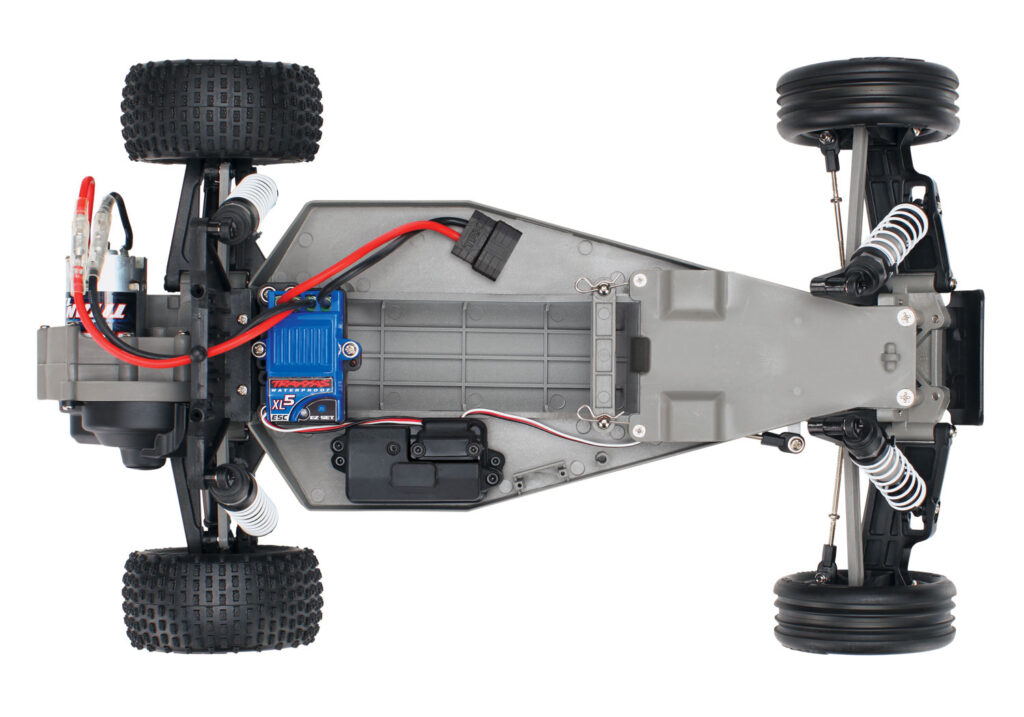
Suspension
In stock form, the suspension seems best suited to very smooth dirt tracks with long sweeping jumps and turns rather than heavy landings and uneven terrain. Thankfully, it isn’t hard to adjust the setup to suit your driving and course conditions.
Traxxas supplies the Bandit with oil-filled Ultra Shocks. These use a dual x-ring design and are customizable with various springs and pistons available for purchase. The shocks can also accept spacers for the coil-over springs for spring pre-load tensioning and ride height adjustments. Rebuild kits are available from Traxxas.
The springs are the white, powder-coated race coils from Traxxas. They’re a single-stage unit and are balanced nicely for the weight and intended use of this vehicle. We found adding larger spacers in front really helped with big landings, whilst replacing the stock oil in the rear shocks with 50 wt. fluid helped slow the heavy end down a bit over bumpy terrain.
How’s It Drive?
Perhaps this is answered best on our review video, which focuses heavily on handling and durability. In a word, the Bandit is fun to drive. It jumps well and once you’ve mentally adjusted to a buggy driving style, it’s quite satisfying to work on smoothing out your inputs and enjoying the improvements in lap times. For general bashing duties, impacts could be a problem with those exposed front wheels, but a nice wide bumper from RPM would help protect the vehicle.
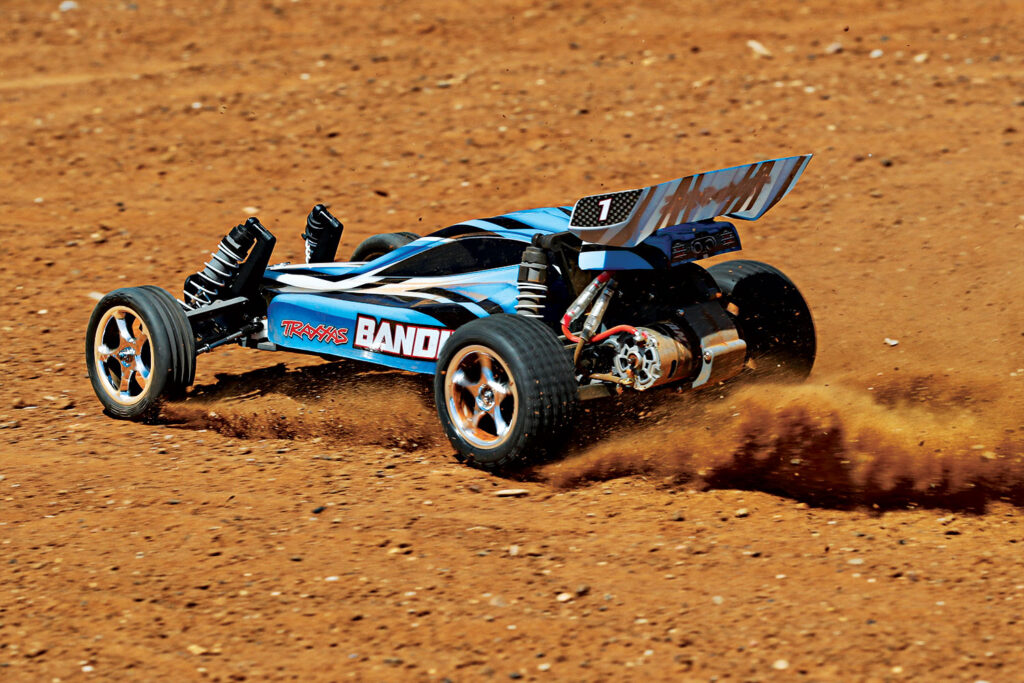
Will It Last?
If you can accept some repairs and maintenance come with operating an RC car on rough terrain at speed, then yes, the Traxxas Bandit will last a good long time. Just be prepared to replace the rear wing and for the wheels to chip and look pretty bad pretty quickly. The rear tires will wear down but there are many options for buggy tires on all sorts of surfaces, so there’s no issue there. The motor will eventually burn out too, but this is cheaply replaced.
Our unit had a control arm failure on the rear left just two batteries in. The screw popped out and the plastic thread was ruined. We had to replace with a slightly larger screw to get the arm back on. Wasn’t a complex fix, but it was a breakage. We cover this in our video review below, too.
Is It Fun?
The current generation of Traxxas Bandit XL-5 is fun and handles well. It’s not a pure race machine, but for the price you can expect a solid starting point if you want to build a budget buggy for local comp meets. For a basher, it’s a light to moderate duty fun machine that will benefit from mechanical sympathy and regular maintenance. The Bandit is a stalwart of the RC off-road hobby and its value proposition for a fun and simple dirt blaster is hard to beat. We’re gonna enjoy running and upgrading ours over the coming summer! Recommended.
More Info
See the manufacturer’s page for the Bandit here.
Find parts and hop-ups here (affiliate link helps support us at no extra cost to you! Thank you for your support!).
If you’re interested in RC crawlers or construction equipment and vehicles, you might want to check out our Reviews section and our YouTube channel.
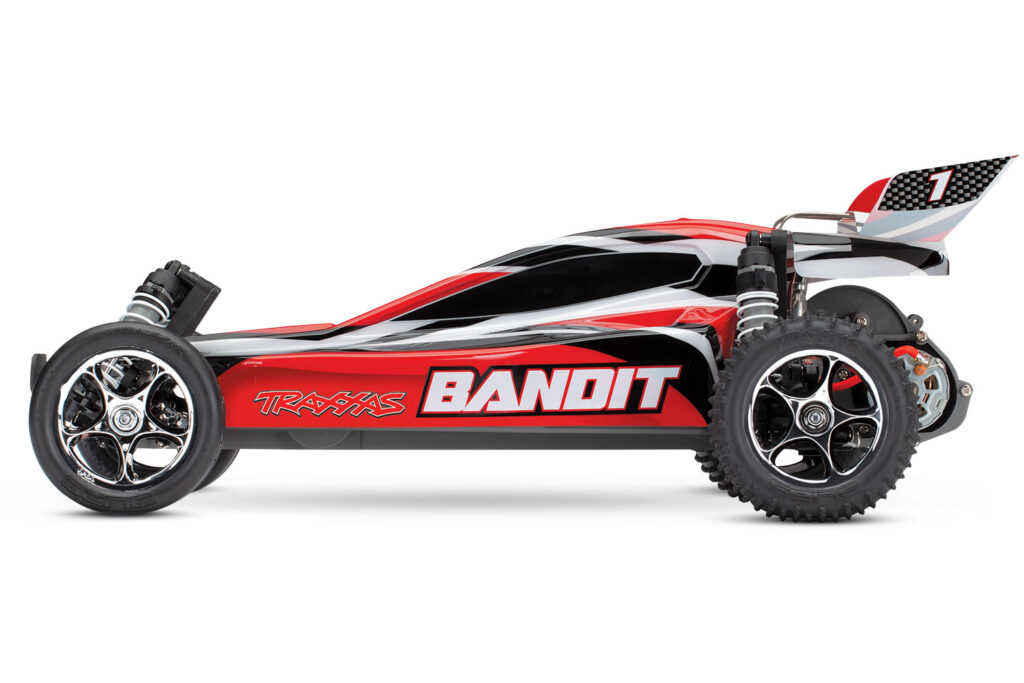

Craig Veness
RC-TNT
Craig has been into radio control since the 90s and into RC crawling since about 2010, when a Losi MRC started the obsession! Now it’s all rocks this and crawl that and upgrade all the things! …You know how it is, right? Welcome home 🙂

